Identification of High-Order Linear Time-Invariant Models from Periodic Nonlinear System Responses †
Abstract
1. Introduction
2. Methodology
2.1. Mathematical Background
2.2. Subspace Identification
2.3. Model-Order Reduction
2.4. Model Matching
2.5. Summary
- The generation of the input–output data from the NLTP system.
- Processing the input–output data with a harmonic analyzer to extract the harmonics of the fundamental frequency of the system.
- Application of subspace identification to identify the higher-order LTI dynamics.
- Removal of spurious higher-order dynamics introduced by the harmonic analyzed via model order reduction.
- Application of model-matching methods to recover the harmonic decomposition form of the identified LTI approximation to the NLTP system.
3. Simulation Model
4. Results
4.1. Identification from LTI Input-Output Data
4.2. Harmonic Analyzer’s Effect on the Identification
4.2.1. Identification from LTP Input-Output Data
4.2.2. Identification from NLTP Input–Output Data
4.3. Model Matching
| Input-Output Data Type | Error, e [%] |
|---|---|
| LTI | 9.0843 |
| LTI + Noise | 0.0767 |
| LTI + Harmonic Analyzer | 0.0026 |
| LTP | 0.328 |
| LTP + Noise | 0.4514 |
| NLTP data | 4.1337 |
5. Conclusions
- The application of harmonic analyzers to decompose input–output data into harmonics of the fundamental frequency of the system introduces spurious dynamics into the identified system. These spurious dynamics make it challenging to determine the correct order of the system. When the order of the system is known, these spurious dynamics can be removed using model order reduction methods such as truncation and residualization. However, some prior knowledge of the system is necessary to remove the spurious dynamics introduced by the harmonic analyzer.
- The mismatch between the identified and exact systems when the identification is performed from LTI input–output data (i.e., for the case where the harmonic analyzer is perfect) is very small. The mismatch grows, but is still acceptable, if the identification is performed using harmonically decomposed LTP and NLTP input–output data.
- Noise is shown to have a negative effect on the accuracy of the identification. Additionally, noise makes it harder to determine the true order of the system.
- Model matching us allowed to recover the harmonic decomposition structure in the identified model. However, previous knowledge of the system to be identified is necessary for this step. This prior knowledge is essential to distinguish genuine system dynamics from spurious dynamics introduced by the harmonic analyzer and the identification process.
Author Contributions
Funding
Institutional Review Board Statement
Informed Consent Statement
Data Availability Statement
Acknowledgments
Conflicts of Interest
Abbreviations
| NLTP | Non-Linear Time-Periodic |
| LTP | Linear Time-Periodic |
| LTI | Linear Time-Invariant |
| HHC | Higher Harmonic Control |
| AFCS | Aircraft Flight Control System |
| LAC | Load Alleviation Control |
| MIMO | Multi-Input Multi-Output |
| MOESP | Multivariable Output Error State sPace |
| LPV | Linear Parameter Varying |
| FWMAV | Flapping-Wing Micro Aerial Vehicle |
| SVD | Singular Value Decomposition |
References
- Friedmann, P.P.; Millott, T.A. Vibration reduction in rotorcraft using active control—A comparison of various approaches. J. Guid. Control Dyn. 1995, 18, 664–673. [Google Scholar] [CrossRef]
- Abraham, M.D.; Olcer, F.E.; Costello, M.F.; Takahashi, M.D.; Tischler, M.D. Integrated Design of AFCS and HHC for Rotorcraft Vibration Reduction using Dynamic Crossfeed. In Proceedings of the 67th Annual Forum of the American Helicopter Society, Virginia Beach, VA, USA, 3–5 May 2011. [Google Scholar]
- Padthe, A.K.; Friedmann, P.P.; Lopez, M.; Prasad, J.V.R. Analysis of High Fidelity Reduced-Order Linearized Time-Invariant Helicopter Models for Integrated Flight and On-Blade Control Applications. In Proceedings of the 41st European Rotorcraft Forum, Munich, Germany, 1–4 September 2015. [Google Scholar]
- Lopez, M.; Prasad, J.V.R.; Tischler, M.B.; Takahashi, M.D.C.K.K. Simulating HHC/AFCS Interaction and Optimized Controllers using Piloted Maneuvers. In Proceedings of the 71st Annual Forum of the American Helicopter Society, Virginia Beach, VA, USA, 5–7 May 2015. [Google Scholar]
- Lopez, M.; Tischler, M.; Takahashi, M.; Cheung, K.; Prasad, J. Development and Evaluation of a Full Flight Envelope Integrated Flight and Vibration Controller. J. Am. Helicopter Soc. 2018, 64, 1–11. [Google Scholar] [CrossRef]
- Saetti, U.; Horn, J.F. Load Alleviation Flight Control Design using High-Order Dynamic Models. J. Am. Helicopter Soc. 2020, 65, 1–15. [Google Scholar] [CrossRef]
- Saetti, U.; Horn, J.F.; Berger, T.; Tischler, M.B. Handling-Qualities Perspective on Rotorcraft Load Alleviation Control. J. Guid. Control Dyn. 2020, 43, 1792–1804. [Google Scholar] [CrossRef]
- Saetti, U.; Lovera, M. Time-Periodic and High-Order Time-Invariant Linearized Models of Rotorcraft: A Survey. J. Am. Helicopter Soc. 2022, 67, 1–19. [Google Scholar] [CrossRef]
- Sanders, J.A.; Verhulst, F.; Murdock, J. Averaging Methods in Nonlinear Dynamical Systems; Chapter Averaging: The periodic case; Springer: Berlin/Heidelberg, Germany, 2007. [Google Scholar]
- Hassan, A.M.; Taha, H.E. Higher-Order Averaging Analysis of the Nonlinear Time-Periodic Dynamics of Hovering Insects/ Flapping-Wing Micro-Air-Vehicles. In Proceedings of the 55th Conference on Decision and Control, Las Vegas, NV, USA, 12–14 December 2016. [Google Scholar] [CrossRef]
- Maggia, M.; Eisa, S.A.; Taha, H.E. On higher-order averaging of time-periodic systems: Reconciliation of two averaging techniques. Nonlinear Dyn. 2020, 99, 813–836. [Google Scholar] [CrossRef]
- Floquet, G. Sur les équations différentielles linéaires à coefficients périodiques. Ann. Sci. De L’École Norm. Supérieure 1883, 2, 47–88. [Google Scholar] [CrossRef]
- Dietl, J.M.; Garcia, E. Stability in Ornithopter Longitudinal Flight Dynamics. J. Guid. Control Dyn. 2008, 31, 1157–1163. [Google Scholar] [CrossRef]
- Bierling, T.; Patil, M. Stability and Power Optimality in Time-Periodic Flapping Wing Structures. J. Fluids Struct. 2013, 38, 238–254. [Google Scholar] [CrossRef][Green Version]
- Su, W.; Cesnik, C.E.S. Flight Dynamic Stability of a Flapping Wing Micro Air Vehicle in Hover. In Proceedings of the 52nd AIAA/ASME/ASCE/AHS/ACS Structures, Structural Dynamics, and Materials Conference, Denver, CO, USA, 4–7 April 2011. [Google Scholar] [CrossRef]
- Lopez, M.J.S.; Prasad, J.V.R. Linear Time Invariant Approximations of Linear Time Periodic Systems. J. Am. Helicopter Soc. 2017, 62, 1–10. [Google Scholar] [CrossRef]
- Saetti, U.; Rogers, J.D. Revisited Harmonic Balance Trim Solution Method for Periodically-Forced Aerospace Vehicles. J. Guid. Control Dyn. 2021, 44, 1008–1017. [Google Scholar] [CrossRef]
- Passaro, M.; Lovera, M. LPV model identification of a flapping wing MAV. In Proceedings of the 4th IFAC Workshop on Linear Parameter Varying Systems, Milan, Italy, 19–20 July 2021; pp. 27–32. [Google Scholar] [CrossRef]
- Armanini, S.F.; de Visser, C.C.; de Croon, H.E.; Mulder, M. Time-Varying Model Identification of Flapping-Wing Vehicle Dynamics Using Flight Data. J. Guid. Control Dyn. 2015, 139, 526–541. [Google Scholar] [CrossRef]
- Gim, H.; Kim, S.; Suk, J.; Cho, S. Longitudinal System Identification of Ornithopter with Automated Flight Tests. In Proceedings of the 20th IFAC Symposium on Automatic Control in Aerospace, Sherbrooke, QC, Canada, 19–20 July 2016; pp. 27–32. [Google Scholar] [CrossRef]
- Hench, J. A technique for the identification of linear periodic state space models. Int. J. Control 1995, 62, 289–301. [Google Scholar] [CrossRef]
- Verhaegen, M.; Yu, X. A class of subspace model identification algorithms to identify periodically and arbitrarily time-varying systems. Automatica 1995, 31, 201–261. [Google Scholar] [CrossRef]
- Van Overschee, P.; De Moor, B. Subspace Identification for Linear Systems. Theory, Implementation, Applications; Springer Science & Business Media: New York, NY, USA, 1996. [Google Scholar]
- Liu, K. Identification of linear time-varying systems. J. Sound Vib. 1997, 206, 487–505. [Google Scholar] [CrossRef]
- Felici, F.; van Wingerden, J.; Verhaegen, M. Subspace identification of MIMO LPV systems using a periodic scheduling sequence. Automatica 2007, 43, 1684–1697. [Google Scholar] [CrossRef]
- Yin, W.; Mehr, A. Identification of linear periodically time-varying systems using periodic sequences. In Proceedings of the 2009 IEEE International Conference on Control Applications, Petersburg, Russia, 8–10 July 2009. [Google Scholar] [CrossRef]
- Louarroudi, E.; Pintelon, R.; Lataire, J. Nonparametric tracking of the time-varying dynamics of weakly nonlinear periodically time-varying systems using periodic inputs. IEEE Trans. Instrum. Meas. 2012, 61, 1384–1394. [Google Scholar] [CrossRef]
- Goos, J.; Pintelon, R. Continuous-time identification of periodically parameter-varying state space models. Automatica 2016, 71, 254–263. [Google Scholar] [CrossRef]
- Wood, T.A. Model-Based Flight Control of Kites for Wind Power Generation. Ph.D. Thesis, ETH Zurich, Zurich, Switzerland, 2011. [Google Scholar]
- Uyanik, I.; Saranli, U.; Ankarali, M.; Cowan, N.; Morgul, O. Frequency-domain subspace identification of linear time-periodic (LTP) systems. IEEE Trans. Autom. Control 2019, 64, 2529–2536. [Google Scholar] [CrossRef]
- Yin, M.; Iannelli, A.; Khosravi, M.; Parsi, A.; Smith, R.S. Linear Time-Periodic System Identification with Grouped Atomic Norm Regularization. In Proceedings of the 21st IFAC World Congress, Berlin, Germany, 11–17 July 2020; pp. 1237–1242. [Google Scholar] [CrossRef]
- Hayajnh, M.; Saetti, U.; Prasad, J. Identification of High-Order Linear Time-Invariant Models from Periodic Nonlinear System Responses. In Proceedings of the VFS 9th Annual ElectricVTOL Symposium, San Jose, CA, USA, 25–27 January 2022. [Google Scholar]
- Van Overschee, P.; De Moor, B. Continuous-time frequency domain subspace system identification. Signal Process. 1996, 52, 179–194. [Google Scholar] [CrossRef]
- Verhaegen, M.; Dewilde, P. Subspace model identification part 1. The output-error state-space model identification class of algorithms. Int. J. Control 1992, 56, 1187–1210. [Google Scholar] [CrossRef]
- Van Overschee, P.; De Moor, B. A unifying theorem for three subspace system identification algorithms. Automatica 1995, 31, 1853–1864. [Google Scholar] [CrossRef]
- Kokotovic, P.; O’Malley, R.; Sannuti, P. Singular perturbations and order reduction in control theory—An overview. Automatica 1976, 12, 123–132. [Google Scholar] [CrossRef]
- Bergamasco, M.; Lovera, M. State space model identification: From unstructured to structured models with an H∞ approach. IFAC Proc. Vol. 2013, 46, 202–207. [Google Scholar] [CrossRef]
- Gahinet, P.; Apkarian, P. Decentralized and fixed-structure H∞ control in MATLAB. In Proceedings of the 2011 50th IEEE Conference on Decision and Control and European Control Conference, Orlando, FL, USA, 12–15 December 2011; pp. 8205–8210. [Google Scholar] [CrossRef]
- Saetti, U.; Rogers, J.D. Harmonic Decomposition Models of Flapping-Wing Flight for Stability Analysis and Control Design. J. Guid. Control. Dyn. 2022, 45, 8. [Google Scholar] [CrossRef]
- Lopez, M.J.S.; Prasad, J.V.R. Estimation of Modal Participation Factors of Linear Time Periodic Systems Using Linear Time Invariant Approximations. J. Am. Helicopter Soc. 2016, 61, 1–4. [Google Scholar] [CrossRef]
- Hernández-González, B.O.; Targui, G.V.P.; Guerrero-Sánchez, M. Robust cascade observer for a disturbance unmanned aerial vehicle carrying a load under multiple time-varying delays and uncertainties. Int. J. Syst. Sci. 2024, 55, 1056–1072. [Google Scholar] [CrossRef]
- Hernández-González, O.; Ramírez-Rasgado, F.; Farza, M.; Guerrero-Sánchez, M.E.; Astorga-Zaragoza, C.M.; M’Saad, M.; Valencia-Palomo, G. Observer for Nonlinear Systems with Time-Varying Delays: Application to a Two-Degrees-of-Freedom Helicopter. Aerospace 2024, 11, 206. [Google Scholar] [CrossRef]

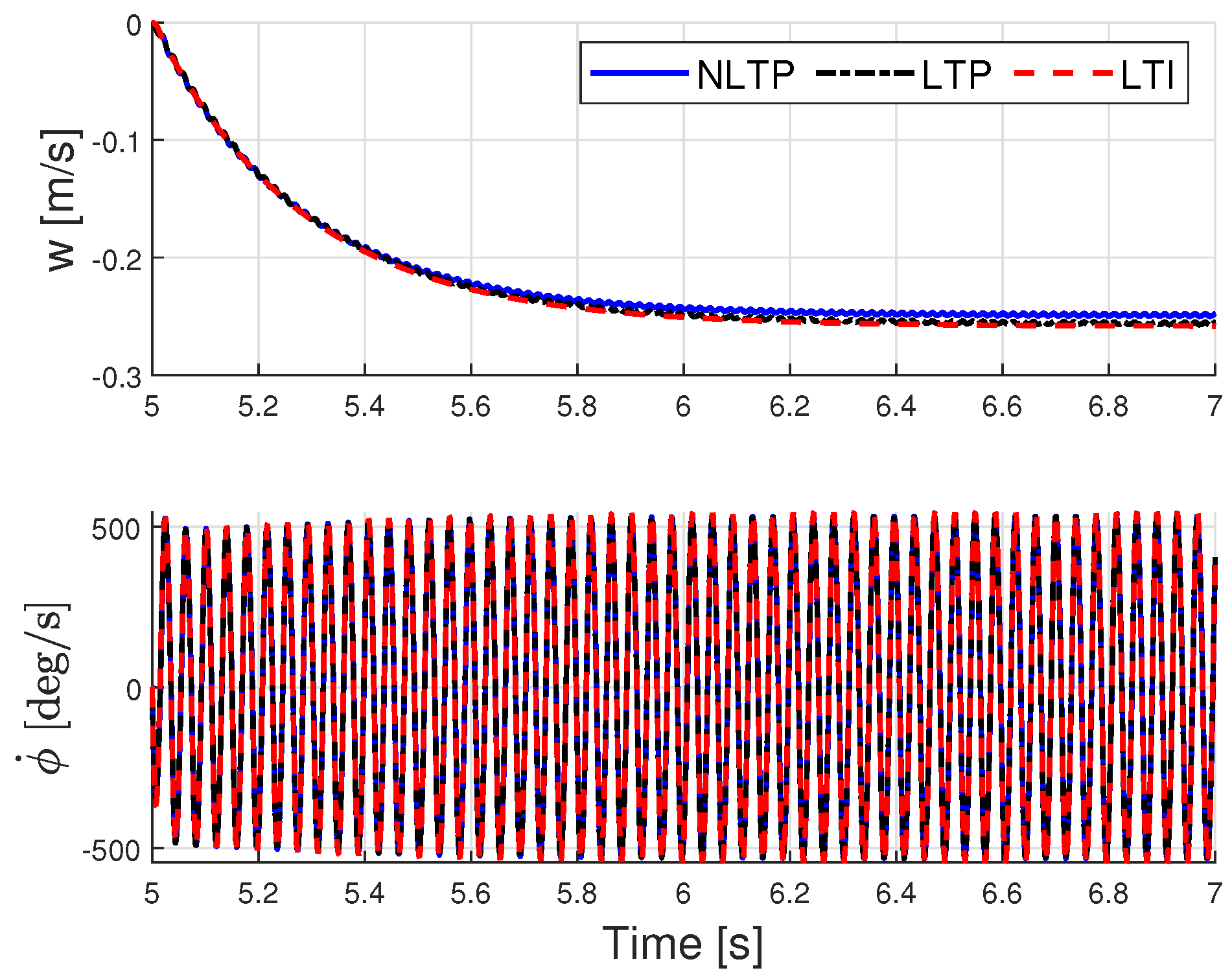
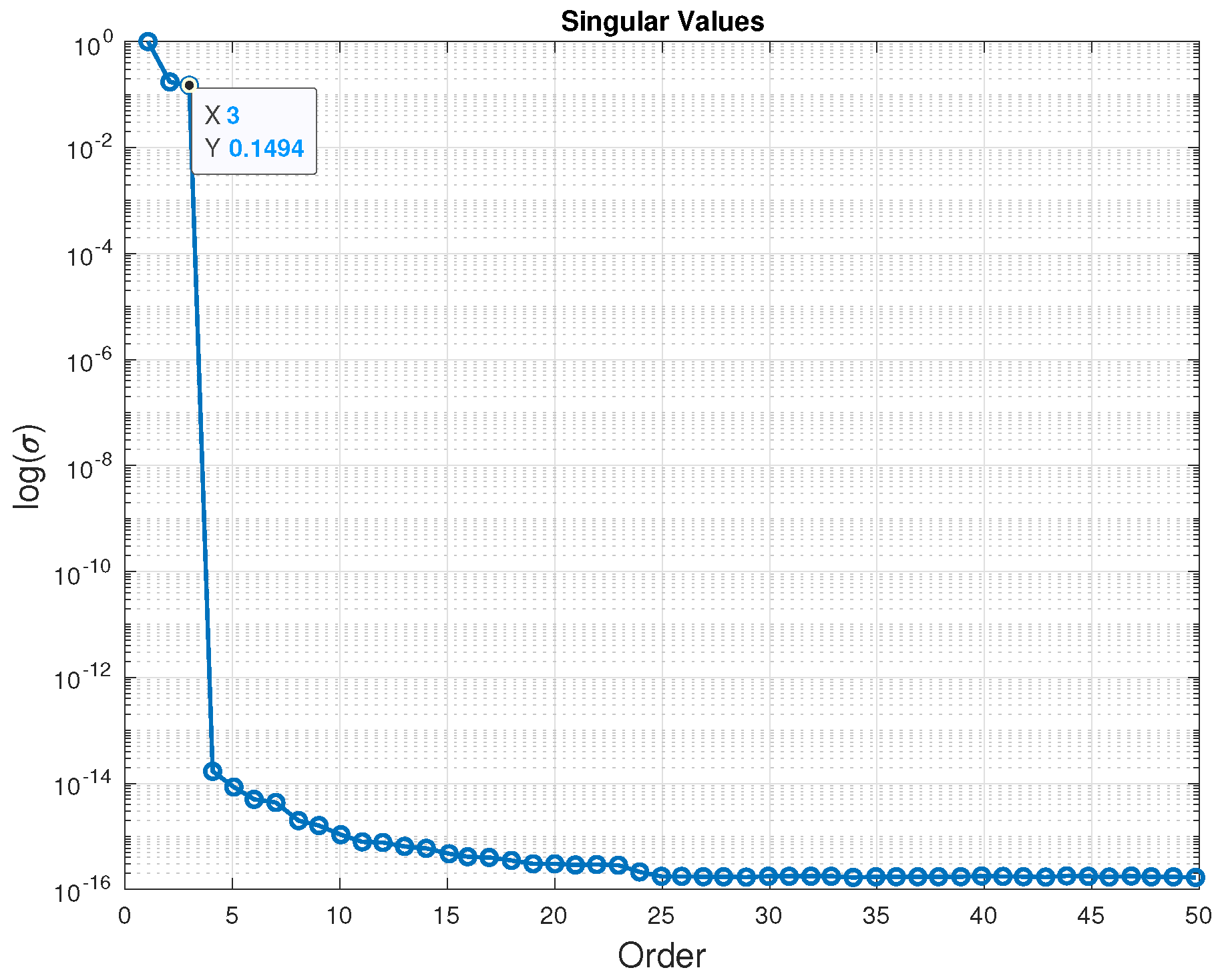

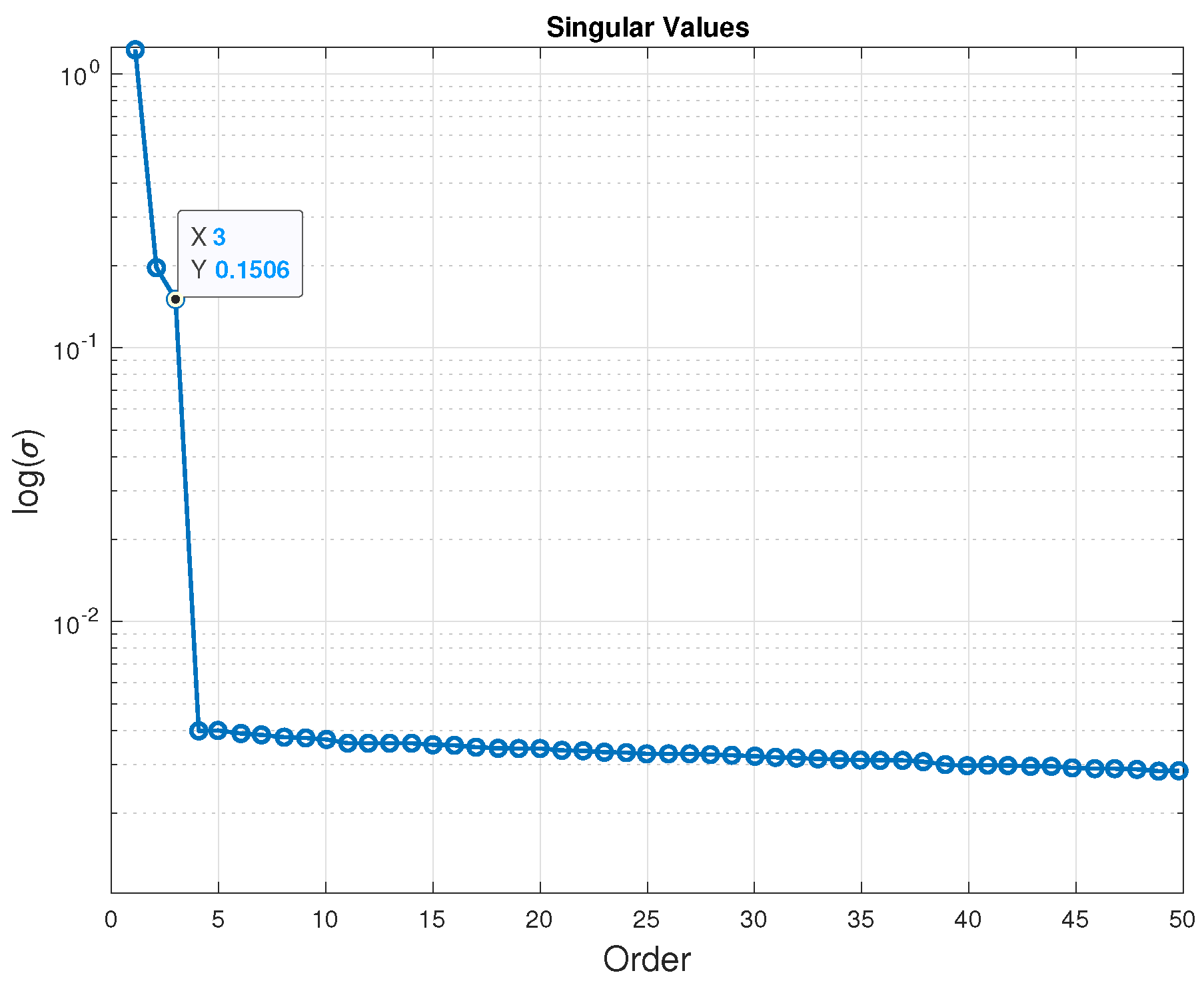
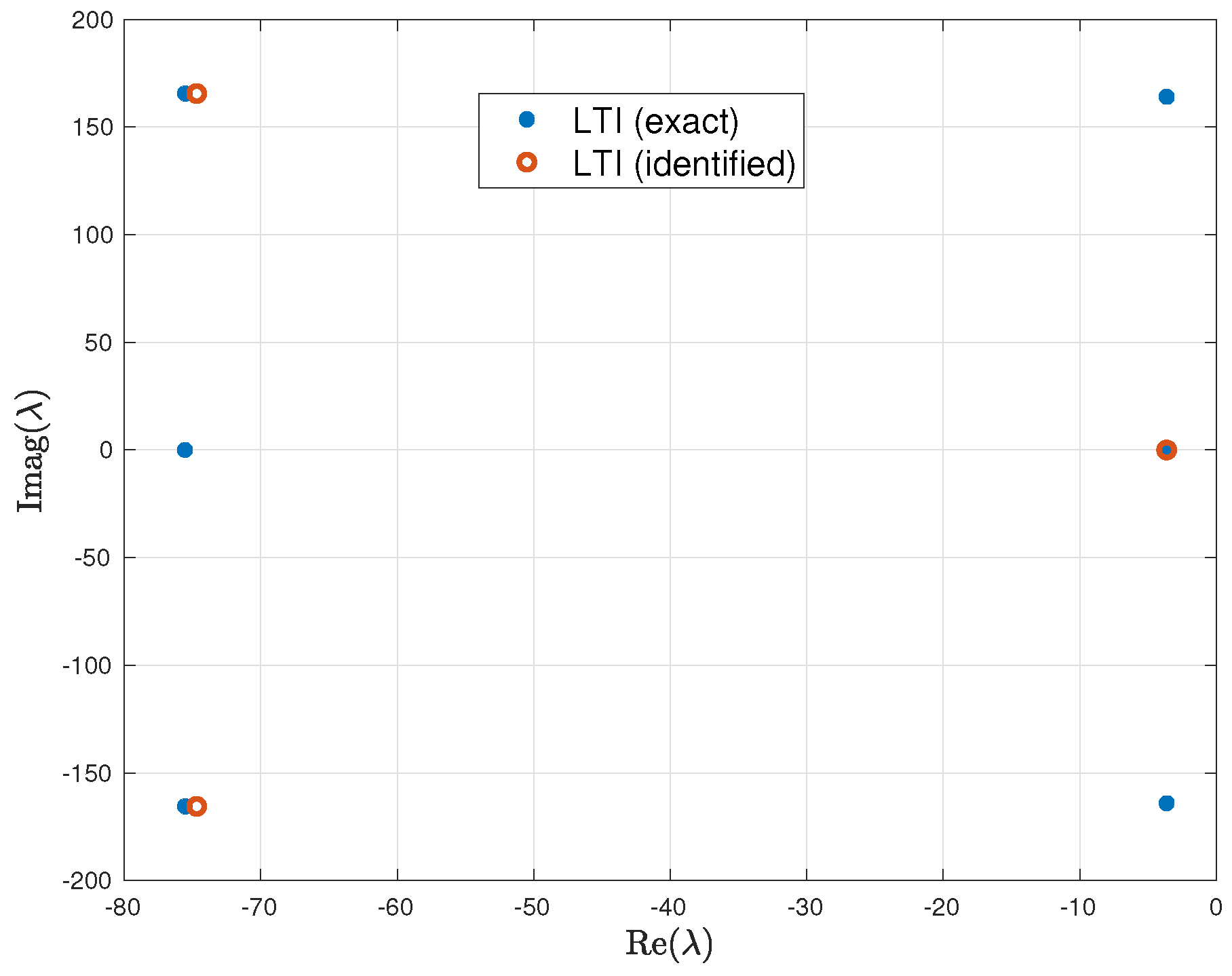
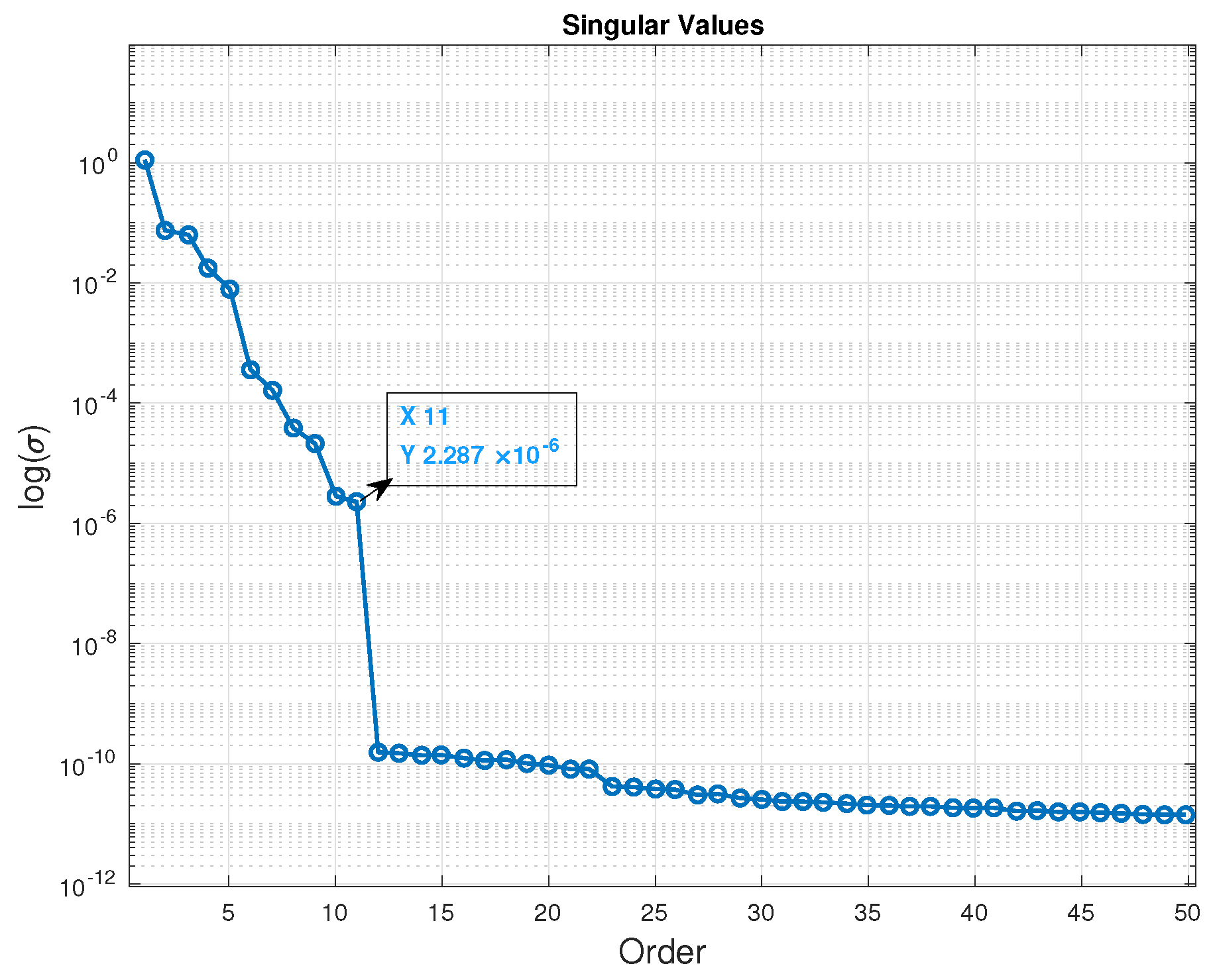
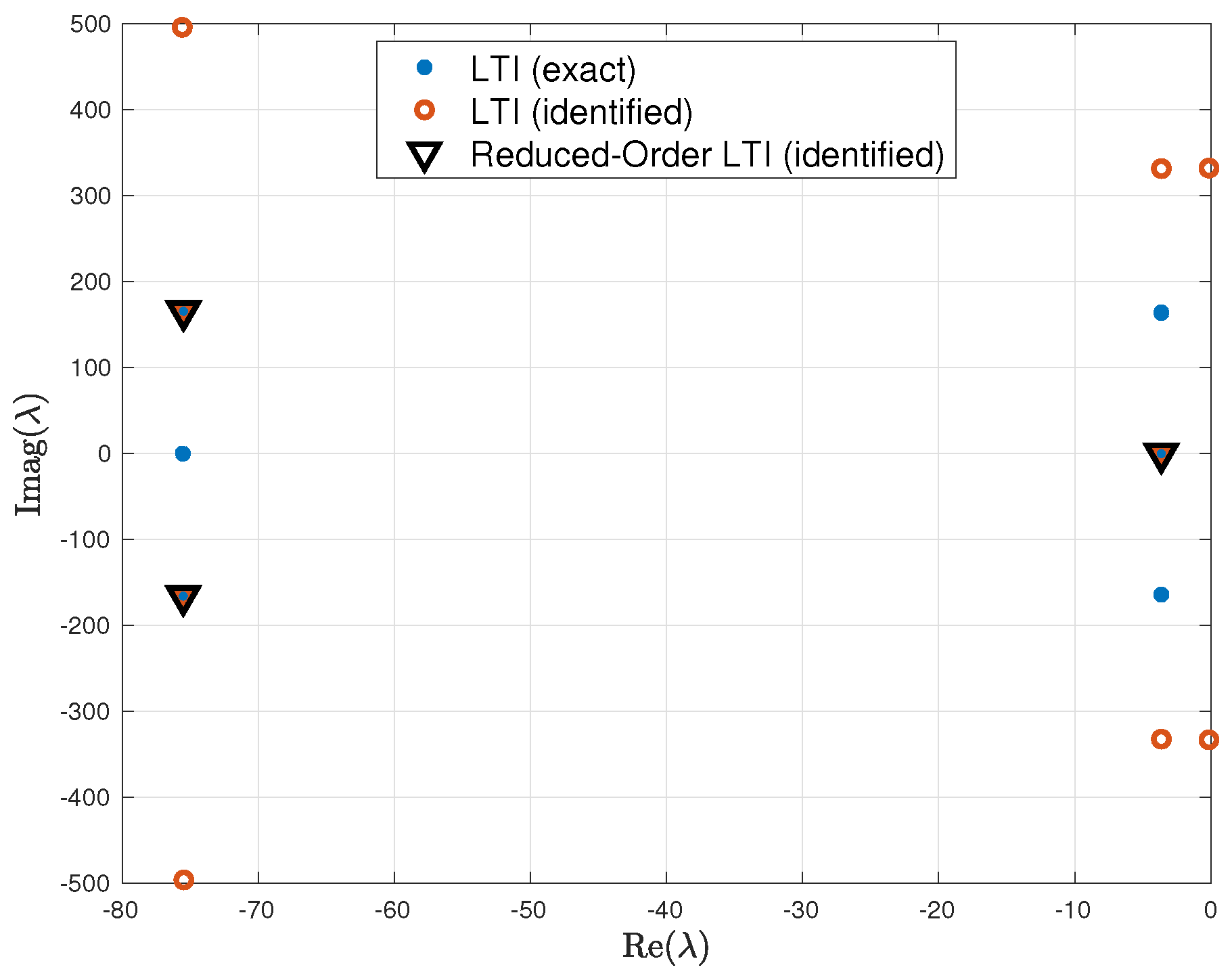

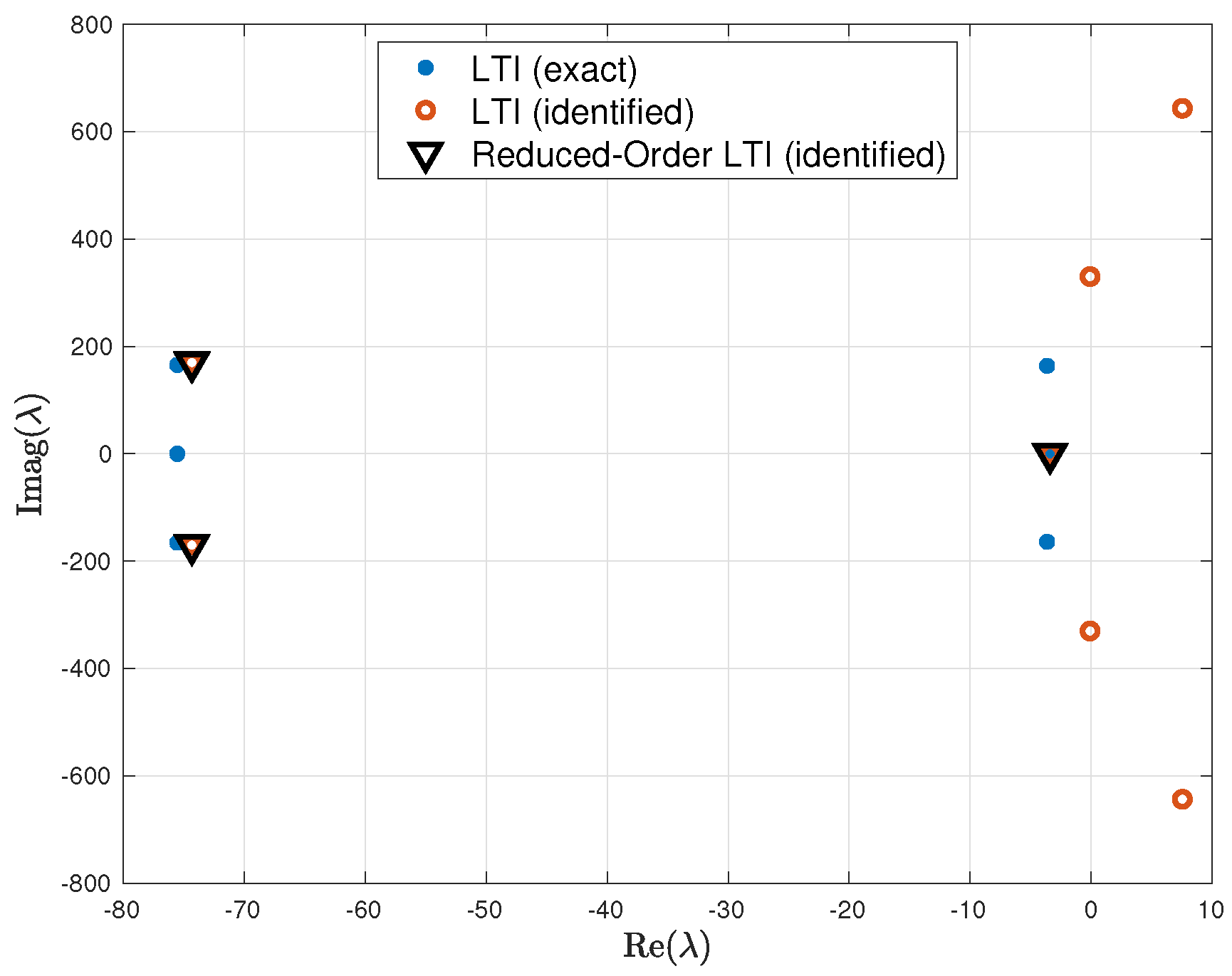
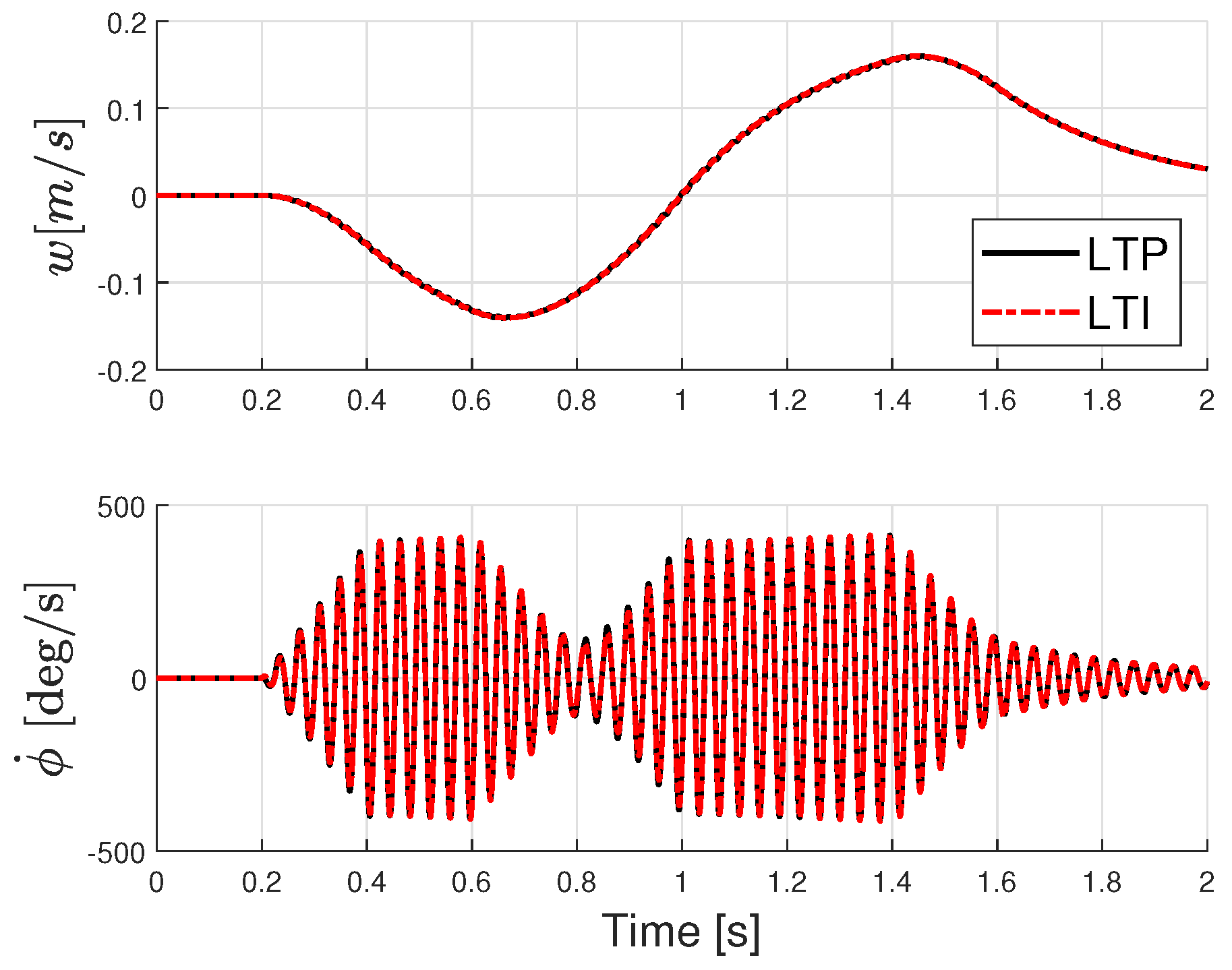

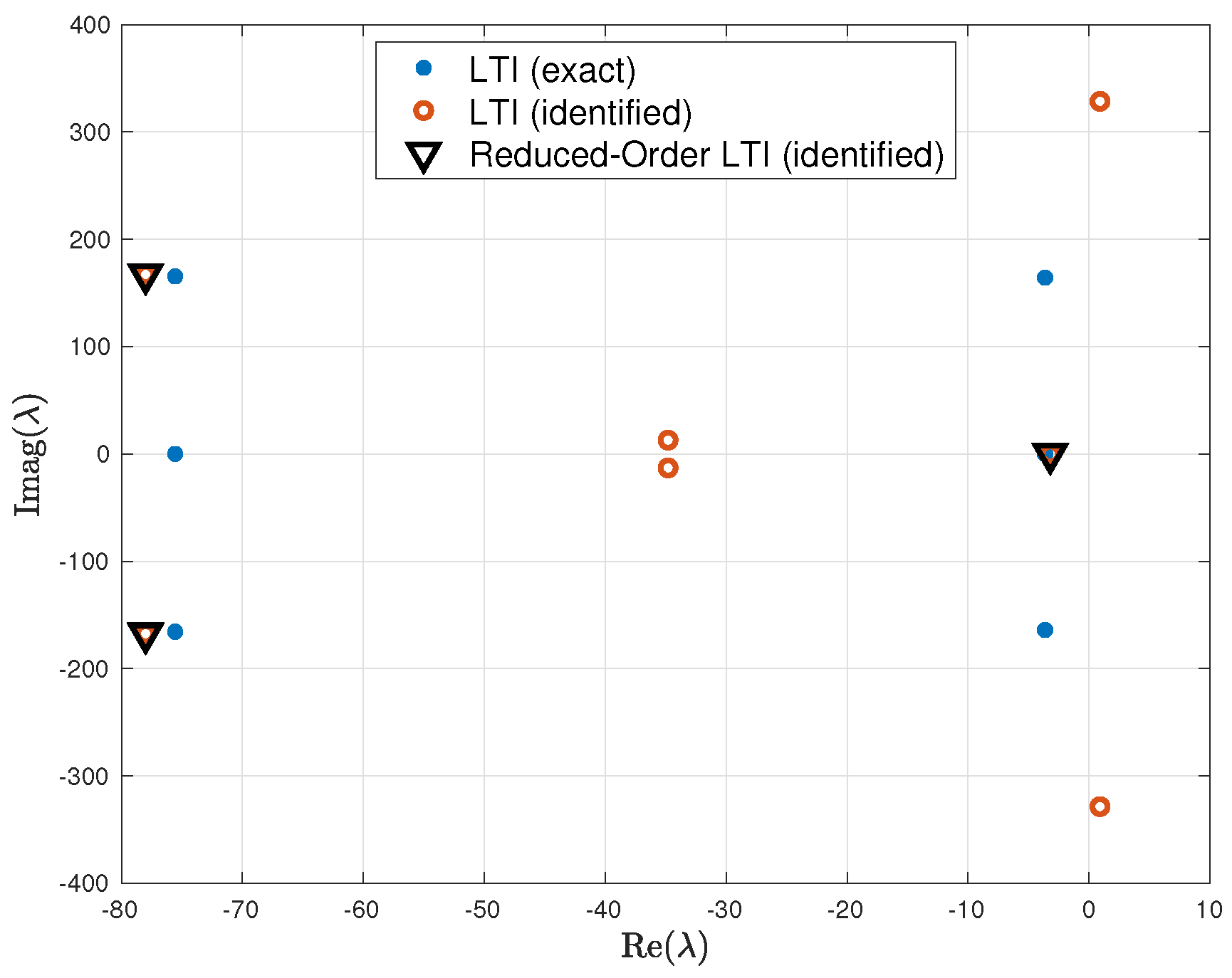
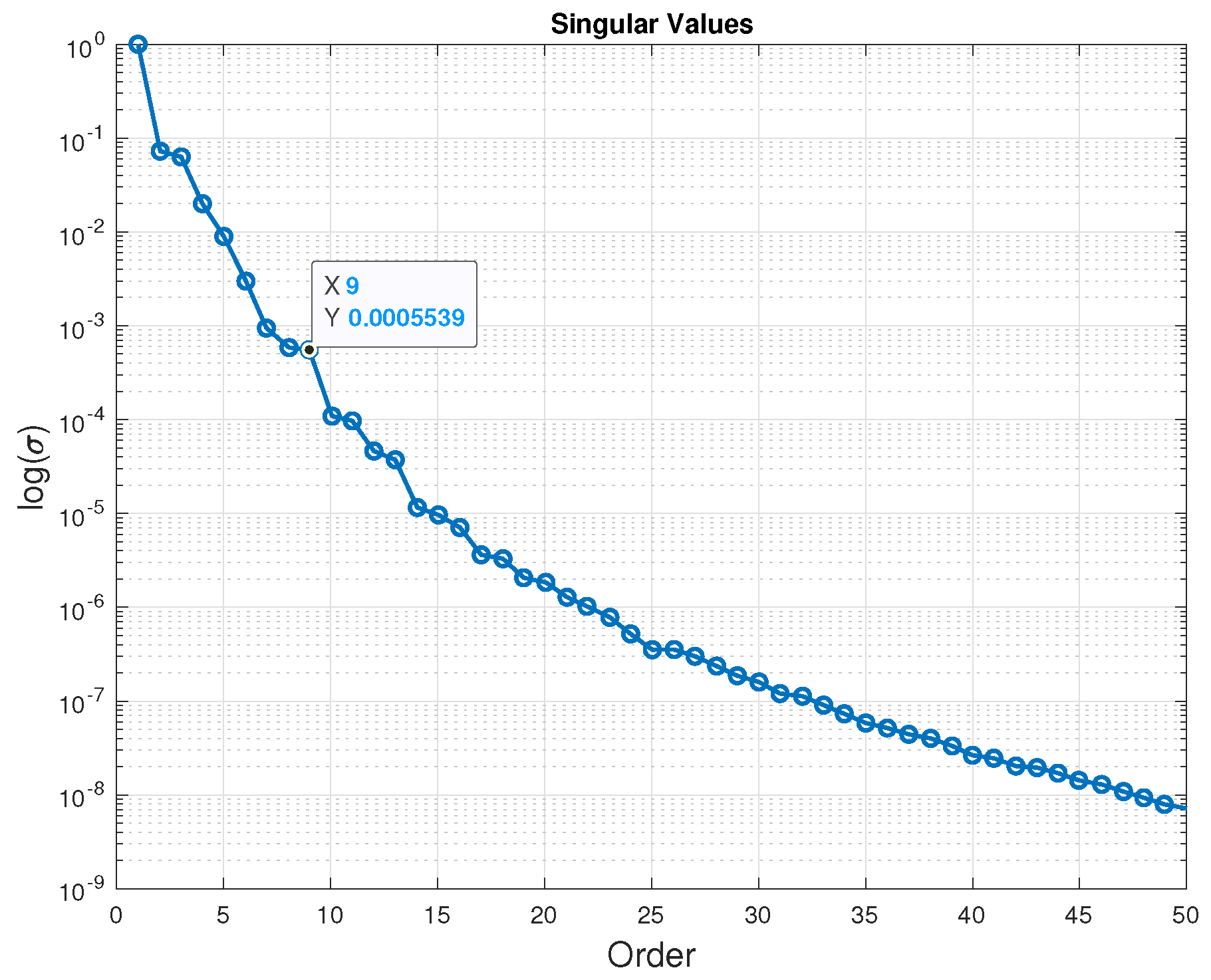

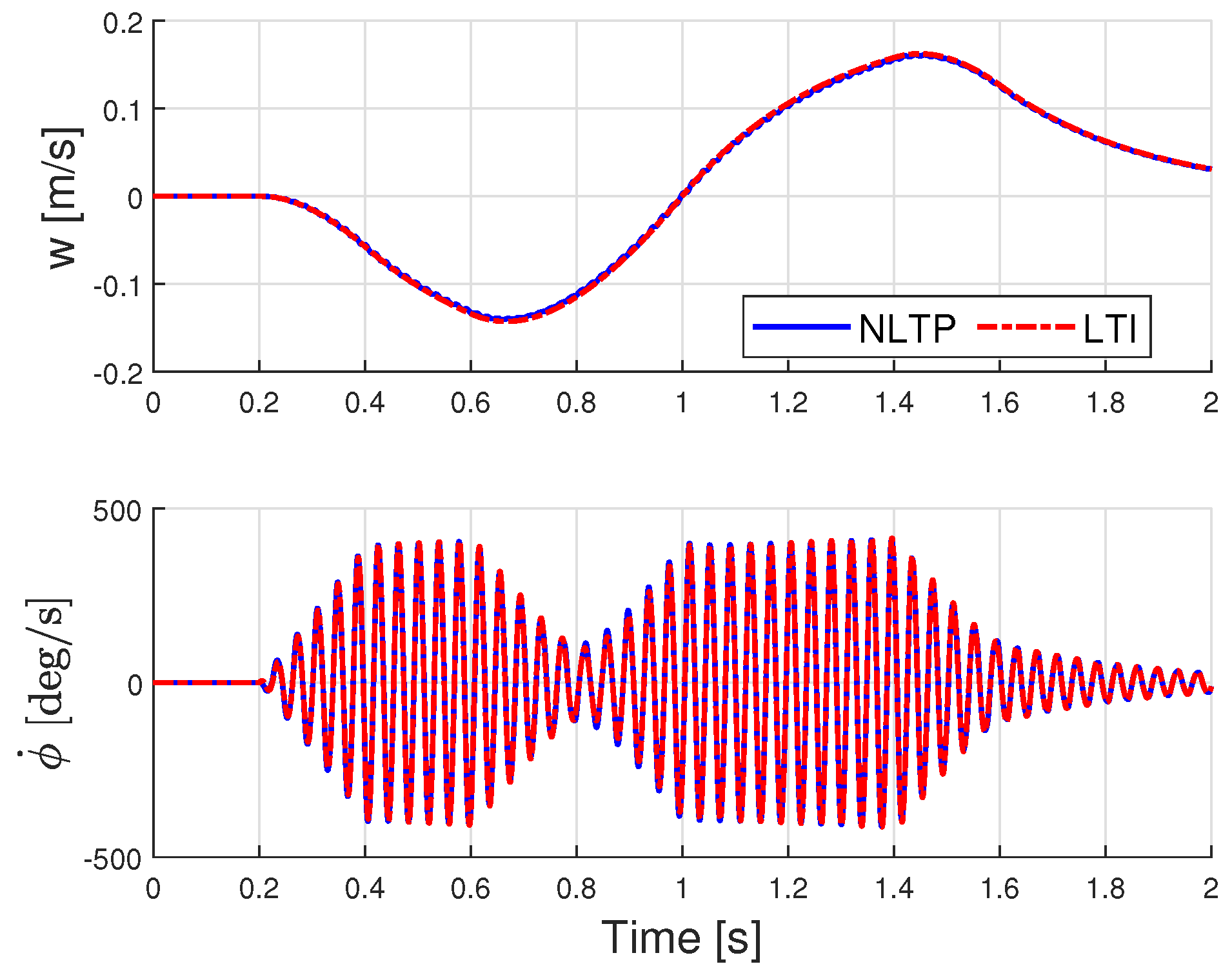
Disclaimer/Publisher’s Note: The statements, opinions and data contained in all publications are solely those of the individual author(s) and contributor(s) and not of MDPI and/or the editor(s). MDPI and/or the editor(s) disclaim responsibility for any injury to people or property resulting from any ideas, methods, instructions or products referred to in the content. |
© 2024 by the authors. Licensee MDPI, Basel, Switzerland. This article is an open access article distributed under the terms and conditions of the Creative Commons Attribution (CC BY) license (https://creativecommons.org/licenses/by/4.0/).
Share and Cite
Hayajnh, M.A.; Saetti, U.; Prasad, J.V.R. Identification of High-Order Linear Time-Invariant Models from Periodic Nonlinear System Responses. Aerospace 2024, 11, 875. https://doi.org/10.3390/aerospace11110875
Hayajnh MA, Saetti U, Prasad JVR. Identification of High-Order Linear Time-Invariant Models from Periodic Nonlinear System Responses. Aerospace. 2024; 11(11):875. https://doi.org/10.3390/aerospace11110875
Chicago/Turabian StyleHayajnh, Mahmoud A., Umberto Saetti, and J. V. R. Prasad. 2024. "Identification of High-Order Linear Time-Invariant Models from Periodic Nonlinear System Responses" Aerospace 11, no. 11: 875. https://doi.org/10.3390/aerospace11110875
APA StyleHayajnh, M. A., Saetti, U., & Prasad, J. V. R. (2024). Identification of High-Order Linear Time-Invariant Models from Periodic Nonlinear System Responses. Aerospace, 11(11), 875. https://doi.org/10.3390/aerospace11110875







